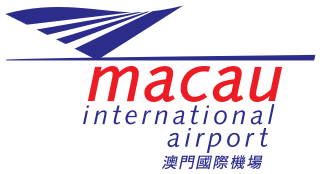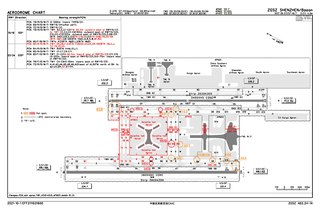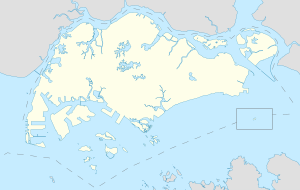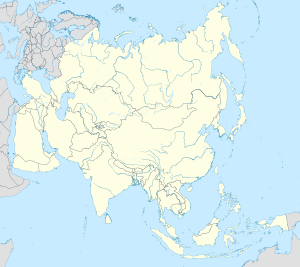
Transport within Singapore is mainly land-based. Many parts of Singapore, including islands such as Sentosa and Jurong Island are accessible by road. The other major form of transportation within Singapore is rail: the Mass Rapid Transit which runs the length and width of Singapore, and the Light Rail Transit which runs within a few neighbourhoods. The main island of Singapore is connected to the other islands by ferryboat services.

Kuala Lumpur International Airport (KLIA), is Malaysia's main international airport and one of the biggest airports in Southeast Asia and worldwide. It is located in Sepang District of Selangor, approximately 45 kilometres (28 mi) south of Kuala Lumpur city centre and serves the Greater Klang Valley conurbation.

Indira Gandhi International Airport is an airport located in the city of Delhi, India that serves as the international aviation hub of the Indian capital of New Delhi as well as the rest of northern India. The airport, spread over an area of 5,106 acres (2,066 ha), is situated in Palam, 15 km (9.3 mi) south-west of the New Delhi railway station and 16 km (9.9 mi) from New Delhi city centre. Named after former Prime Minister of India Indira Gandhi, it is the busiest airport in India in terms of passenger traffic since 2009. It is also the busiest airport in the country in terms of cargo traffic, overtaking Mumbai during late 2015. In the calendar year 2018, it was the 12th busiest airport in the world and 6th busiest airport in Asia by passenger traffic handling nearly 70 million passengers. It is the world's busiest airport for Airbus A320 aircraft. The under construction expansion program will increase the airport's capacity to handle 100 million passengers by 2030.

Macau International Airport is an international airport in the special administrative region of Macau, situated at the eastern end of Taipa island and neighbouring waters which opened for commercial operations on 9 November 1995, during Portuguese administration of the region.

Singapore Airlines (SIA) is the flag carrier airline of Singapore with its hub at Singapore Changi Airport. The airline is notable for using the Singapore Girl as its central figure in corporate branding. It has been ranked as the world's best airline by Skytrax four times and topped Travel & Leisure's best airline rankings for more than 20 years.

Incheon International Airport (IIA) (Korean: 인천국제공항) is the largest airport in South Korea, the primary airport serving the Seoul Capital Area, and one of the largest and busiest airports in the region. It has been rated as the one of the world's cleanest airports and highly rated international transit airports by Skytrax together with Singapore Changi Airport and Tokyo Haneda Airport.

Taiwan Taoyuan International Airport is an international airport serving Taipei and northern Taiwan. Located about 40 km (25 mi) west of Taipei in Dayuan District, Taoyuan, the airport is Taiwan's largest and busiest airport. It is operated by the Taoyuan International Airport Corporation. In 2016, it was ranked the best airport for its size in the Asia-Pacific region by Airports Council International.

Suvarnabhumi Airport, also known unofficially as Bangkok Airport, is one of two international airports serving Bangkok, Thailand. The other one is Don Mueang International Airport, which was the main international airport from 1924 to 2006 and transitioned in 2007 to become the low-cost airlines hub for Bangkok. Suvarnabhumi Airport covers an area of 3,240 ha, making it one of the biggest international airports in Southeast Asia and a regional hub for aviation. The airport is also a major Cargo Air Freight Hub, which has a designated Airport Free Zone, as well as road links to the East Economic Corridor (EEC) on Motorway 7.

Changi is a planning area located in the geographical region of Tanah Merah in the East Region of Singapore. Sharing borders with Pasir Ris and Tampines to the west, Changi Bay to the southeast, the South China Sea to the east and the Serangoon Harbour to the north. Changi, excluding the two water catchments and islands of Singapore, is the largest planning area by land size.

Sharjah Airport is an airport located 7 nautical miles east-southeast of Sharjah, United Arab Emirates. It is spread over an area of 15,200,000 m2.

Naha Airport is a second class airport located 4 km (2.5 mi) west of the city hall in Naha, Okinawa. It is Japan's seventh busiest airport and the primary air terminal for passengers and cargo traveling to and from Okinawa Prefecture, Japan, and handles scheduled international traffic to Taiwan, Hong Kong, South Korea, Thailand, Singapore and mainland China. The airport is also home to Naha Air Base of the Japan Air Self-Defense Force.

SATS Ltd., commonly abbreviated as SATS is the chief ground-handling and in-flight catering service provider at Singapore Changi Airport. SATS controls about 80% of Changi Airport's ground handling and catering business.

Shenzhen Bao'an International Airport is the airport serving Shenzhen, Guangdong Province. It is located on the east bank of the Pearl River near Huangtian and Fuyong villages in Bao'an District, and is 32 km (20 mi) northwest of the city center. It is a hub for Shenzhen Airlines and Shenzhen Donghai Airlines and for cargo airline SF Airlines, and a focus city for China Southern Airlines and Hainan Airlines. The airport also serves as an Asian-Pacific cargo hub for UPS Airlines. The airport is undergoing major expansions with a second runway completed and opened in 2011 and a new terminal which opened in 2013.

Penang International Airport is one of the busiest airports in Malaysia. The airport is located near Bayan Lepas at the southeastern tip of Penang Island, 16 km (9.9 mi) south of the city centre. Previously known as the Bayan Lepas International Airport, it was opened in 1935, making it the oldest airport in the country.

Nội Bài International Airport in Hanoi, the capital of Vietnam, is the largest airport in Vietnam in terms of total capacity. It is also the second busiest airport in Vietnam after Tan Son Nhat International Airport. It is the main airport serving Hanoi, replacing the role of Gia Lam Airport. The airport consists of two passenger terminals. Terminal 1 serves domestic flights, and the newly built Terminal 2 serves all international flights to and from Hanoi. The airport is currently the main hub of the flag carrier Vietnam Airlines, and budget carriers Bamboo Airways, Jetstar Pacific and Vietjet Air.

Kota Kinabalu International Airport (KKIA) is an international airport in Kota Kinabalu, the state capital of Sabah, Malaysia. It is located approximately 8 km (5.0 mi) southwest of the city centre. In 2017, 8 million passengers passed through the airport, making it the second busiest airport in Malaysia after Kuala Lumpur International Airport. A medium-sized airport with good connections to most major aviation hubs across the Asia-Pacific region, the airport serves the city of Kota Kinabalu as well as the entire west coast of Sabah.

Scoot Tigerair Pte Ltd, operating as Scoot, is a Singaporean low-cost airline which is a subsidiary of Singapore Airlines. It launched flights on 4 June 2012 on medium and long-haul routes from Singapore, predominantly to Australia, China, and India. Initially, Scoot's fleet consisted of Boeing 777 aircraft obtained from Singapore Airlines. The airline began to transition its fleet to the Boeing 787 Dreamliner aircraft from 2015. On 25 July 2017, Tigerair was officially merged into Scoot using Tigerair's air operator's certificate (AOC) but retaining the 'Scoot' brand. With the change of AOC, the airline's IATA code was changed from TZ to TR, and its ICAO code was changed from SCO to TGW, previously used by Tigerair. Its head office is at Singapore Changi Airport.
Singapore Changi Airport, or simply Changi Airport, is the primary civilian airport in the Republic of Singapore, and one of the largest transportation hubs in Southeast Asia. It is located approximately 17.2 km (10.7 mi) northeast from the commercial centre in Changi, on a 13 square kilometres (5.0 sq mi) site.

Singapore Changi Airport is Singapore's primary international airport and a major aviation hub in Asia. It is currently rated the World's Best Airport by Skytrax. It is located approximately 17.2 km (10.7 mi) from the city's commercial centre, on a 13-square-kilometre (5.0 sq mi) site on the easternmost point of the main island.
































